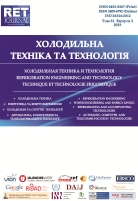DEVELOPMENT POSSIBILITIES OF NEW STIRLING REFRIGERATING MACHINES ON THE BASIS OF EXISTING CONSTRUCTIONS
DOI:
https://doi.org/10.15673/0453-8307.2/2015.39347Keywords:
Stirling refrigerating machine Cooling capacity losses Dimensionless complexes similarity.Abstract
In the given paper the possibility of new Stirling refrigerating machine development on the basis of existing design has been considered. For refrigerating machine process analysis the isothermal model of Stirling cycle and method of separate loss analysis were used. Ambient and cooling temperatures were assumed constant in equation for cooling capacity calculation. The dimensionless complexes, namely, ideal cooling capacity and complexes taking into account cooler regenerator losses due to non-ideal heat exchange, hydraulic resistance and axial matrix heat flow have been obtained after mathematical transformation of the governing equations. According to the theory of similarity the pairwise equalities of heat exchanger volume simplexes (targeted volume divided by volume of refrigerator expansion space) and dimensionless complexes is needed for similarity of new and basis Stirling refrigerating machine. The equality of dimensionless complexes is achieved with equal regenerator length for both new refrigerator and basis cooler. For confirmation of this conclusion the basis refrigerator KGM-9000/80-1 with known experimental data and new designed refrigerator with cooling capacity 200 W have been used. For parameters calculation of refrigerators the one-dimensional mathematical model based on structure-module approach was used. The identical effectiveness for both coolers has been obtained. Variation of maximum pressure and working frequency of cycle does not allow creating new similarity Stirling refrigerating machine due to complicated influence of these parameters on dimensionless loss complexes. The procedure of effectiveness and refrigerating capacity increasing while changing the working frequency and maximum pressure for new refrigerator also has been shown.
References
Twinbird Corp.: free-piston Stirling cooler. Twinbird free-piston Stirling Cooler. – Available at: http://fpsc.twinbird.jp/legacy/en/index.html 2. Ultra Low Freezers. Stirling Ultracold. – Available at: http://stirlingultracold.com/ultralow_freezers 3. Dyson R.W., Wilson S.D., Tew R.C., Demko R. 2005. On the Need of Multidimensional Stirling Simulations. Third International Energy Conversion Conference. – San Francisco, California, 15 -18 August, 2005. doi: 10.2514/6.2005-5557 4. Novotelnov V.N., Suslov A. D., Poltoraus V. B., Novotelnov V. N. 1991. Kriogennyie mashiny – Spb.: Politehnika, – 335 p. 5. Uoker G. 1985. Dvigateli Stirlinga. – M.: Mashinostroenie. – 408 p. 6. Kutateladze S. S. 1982. Analiz podobiya v teplofizike. Novosibirsk: Nauka, 280 s. 7. Cheng P., Zhao T. S. 1998. Transport phenomena in an orifice pulse tube refrigerator/cryocooler. Thermal science and engineering, 6(1), 4551. 8. Choi S., Nam K., Jeong S. 2004. Investigation on the pressure drop characteristics of cryocooler regenerators under oscillating flow and pulsating pressure conditions. Cryogenics, vol. 44, iss.3, 203210. doi: 10.1016/j.cryogenics.2003.11.006 9. Tanaka M., Yamashita I., Chisaka F. 1990. Flow and heat transfer characteristics of the Stirling engine regenerator in oscillating flow. JSME International Journal, 33(2), 283289. 10. Xiaoqin Yang, Chung J. N. 2005. Size effects on miniature Stirling cycle cryocooler. Cryogenics, vol. 45, 537545. doi: 10.1016/j.cryogenics.2005.02.005 11. Kukharenko V.N., Kuznetsov V.V. 2009. Mathematical simulation of thermophysical processes in low – temperature gas machines using structural – module approach. Kholodylna Tekhnika ta Tekhnologiya [Refrigeration Engineering and Technology], No.5(121), 1114.


